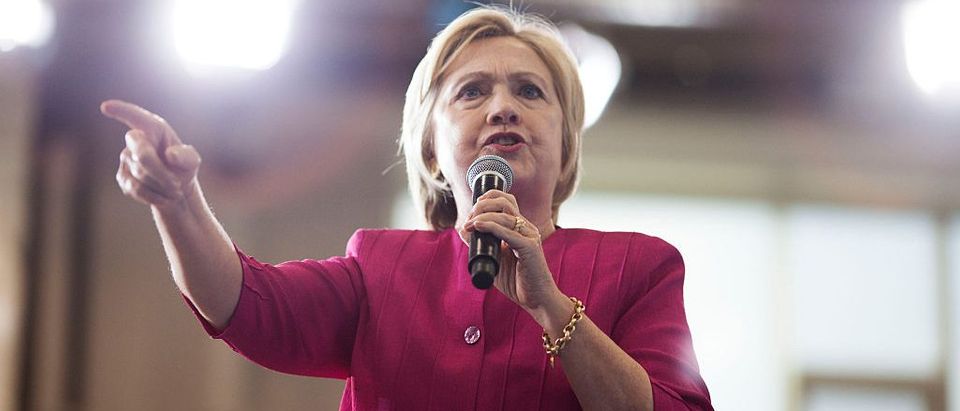Deplorable as Clinton’s race-based attacks on Trump are, her political weaknesses make them predictable. Unable to increase her support, her best hope is to reduce Trump quickly. Clinton’s biggest danger is Trump gaining traction at the end of this race – just as he did in the Republican primaries – while the public’s rejection of her undermines her ability to stop him.
The week of August 22nd marked Hillary Clinton’s unabashed use of race in this campaign. By equating Trump and his supporters of “taking hate groups mainstream,” she reached for the ultimate in-case-of-emergency-break-glass liberal survival tool. That charge is now made – a charge so inflammatory in American society that it often need not have evidence before condemning the accused.
As sad as it is to see a presidential campaign so lowered, Clinton’s act of desperation equals her potential circumstances.
While Clinton’s campaign is in a relatively good place, she is still in bad shape. That conundrum between campaign and candidate is her predicament. Despite a resume 25 years in the making, a better Convention than her rival, kid-glove media coverage, and leads in most polls, she still has abysmal favorability ratings.
Gallup’s latest survey (released 8/11) found Clinton with just a 39% rating her favorably. That is where she was before her post-Convention bounce. More significantly, it is far lower than any of the last three presidents at the same stage in their first election. In August of 1992, Bill Clinton had a 59% rating; in 2000, George W. Bush’s rating was 67%; and in 2008, Obama had a 63% favorability rating.
Clinton’s 39% is also far worse than any recent nominees who lost the presidency. In 1996, Dole had a 49% favorability rating; in 2000, Gore’s 52%; in 2004, Kerry had 52%; in 2008, McCain’s 59%; and in 2012, Romney had 48%.
All this comes even when the public is comparing Clinton to an opponent with a still lower 32% rating. Clinton even appears unable to appreciably benefit from a comparison with Trump.
So if circumstances are as good as they could be for Hillary’s campaign, how much worse could they be? A lot.
The latest chapter in her email serial saga proves it is not closing before the election – if ever. And with each passing episode it gets worse, as its potential for ever more adverse revelation grows. Only Clinton knows what is in these, but she may not be alone in that knowledge much longer.
At home, the economy remains poor, with 2016’s weak first half following in form the previous seven years, in which real GDP growth averaged just 1.5%. Abroad, any negative event offers the opportunity for voters to reflect on Hillary shaping and leading this administration’s foreign policy.
However her unpopularity and potential problems are not Hillary’s only reason for playing her emergency race card so soon.
On one hand, it is clear Clinton’s standing with the public is not going to improve. After a quarter of a century, America feels it knows her and it does not care for her. There appears nothing she can do to change that.
On the other hand, Clinton’s campaign knows that while she limped across her Party’s nomination finish-line, Trump grew stronger as the Republican contest progressed.
Early in the Republican race, Trump appeared to be only relatively strong: A famous personality holding a third of the voters, while 16 others split the remainder. However as the 16 fell away, Trump continued to grow. Even the Cruz-Kasich Conservative-Establishment alliance failed to stop Trump’s momentum.
Clinton’s campaign must worry that he could “close strong” again. Already he is holding double-digit percentages of Democrats – far higher than recent Republican nominees. His recent what-have-you-got-to-lose appeal to African American voters is another serious threat.
The three major voter groups most strongly supporting Democrats for president are: Democrats, liberals, and Blacks. Hillary is already losing appreciable percentages of Democrats to Trump and she never won over liberals in her nomination fight with Sanders. A challenge for Black support cannot go unanswered and another reason Clinton is playing the race card.
Of course, her strategy is as flammable as it is inflammatory. Americans are already hyper-sensitized on race relations. As a recent (released 8/26) Rasmussen poll showed, they overwhelmingly (60%) believe race relations have gotten worse during Obama’s presidency (just 9% believing they have improved). And 50% believe they are getting worse.
Clinton’s risk is that her racism strategy may not just not work, but backfire. Already perceived unfavorably and distrusted by the majority of Americans, she could be seen as simply self-serving. Such a perception could further undermine her low standing at the same time it devalues America’s political discussion and further split an already seriously divided nation.
J.T. Young served in the Treasury Department and the Office of Management and Budget from 2001 to 2004 and as a Congressional staff member from 1987 to 2000.


